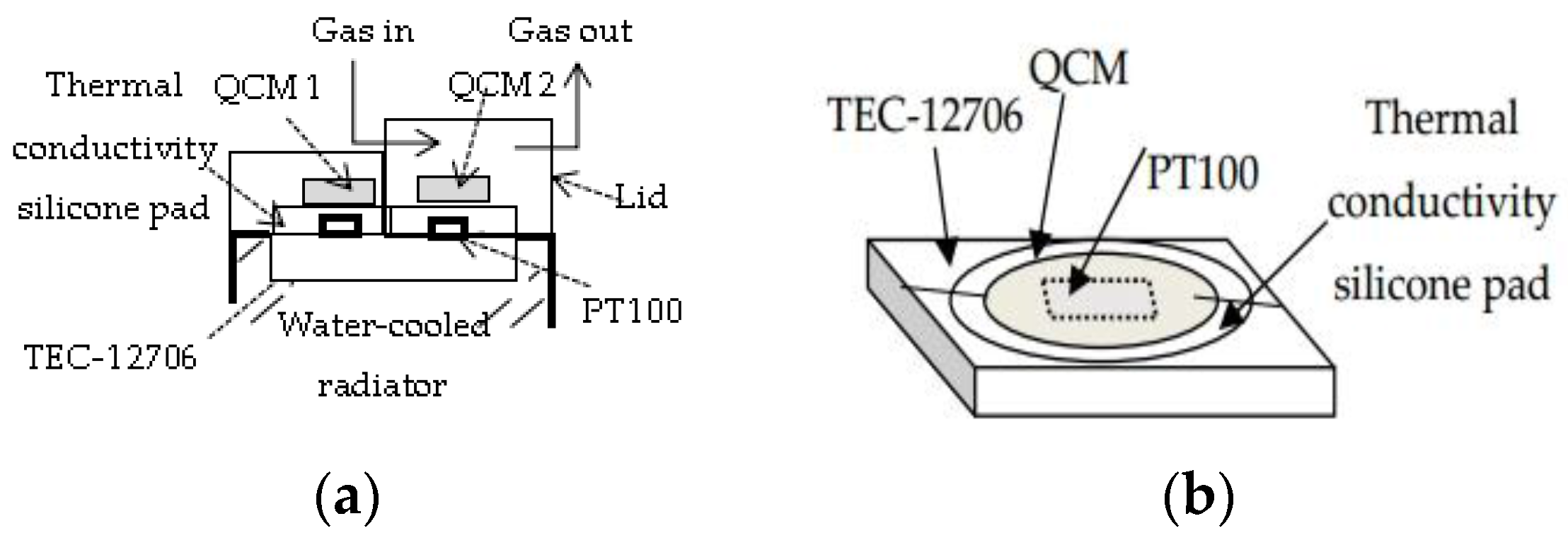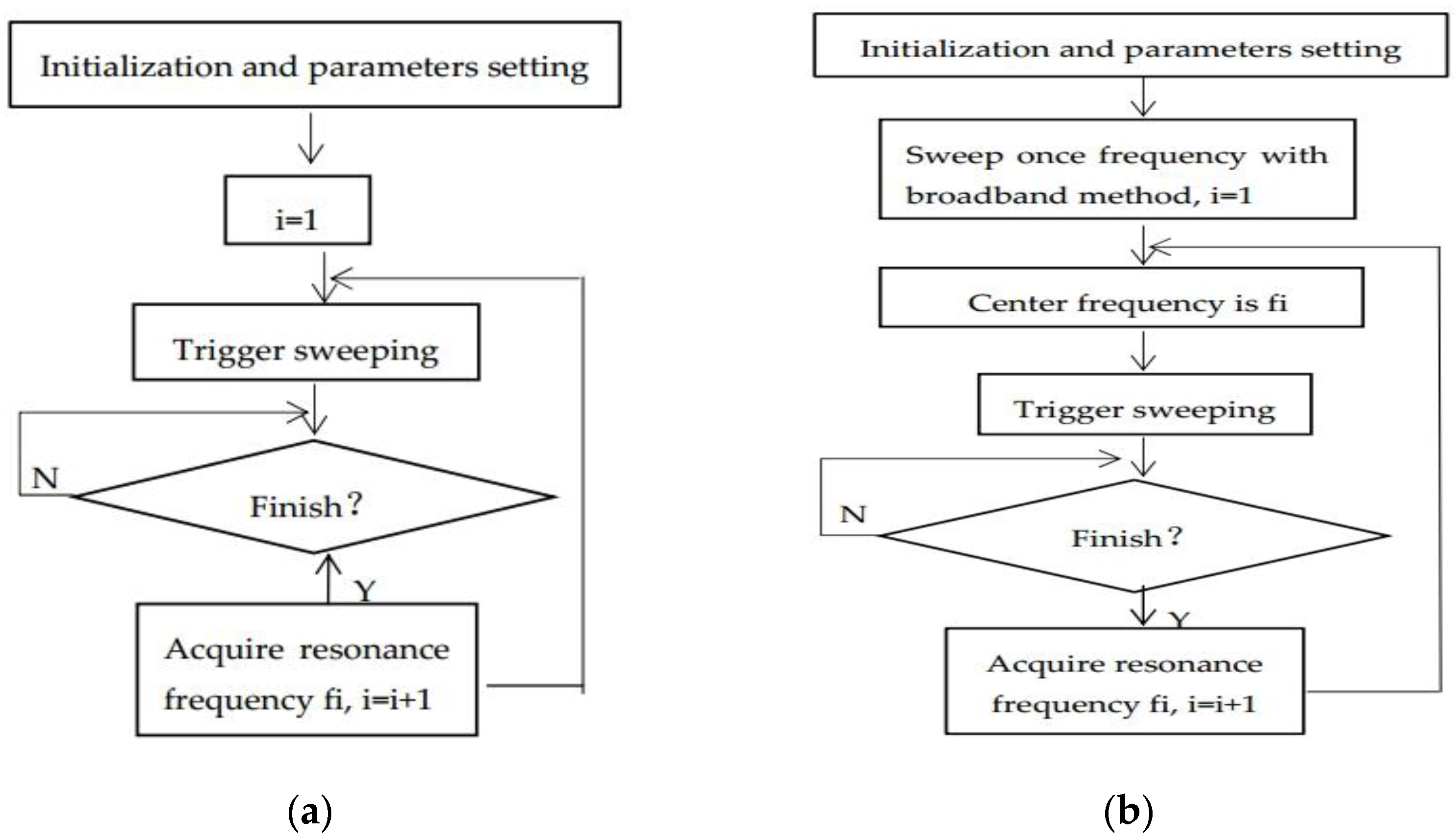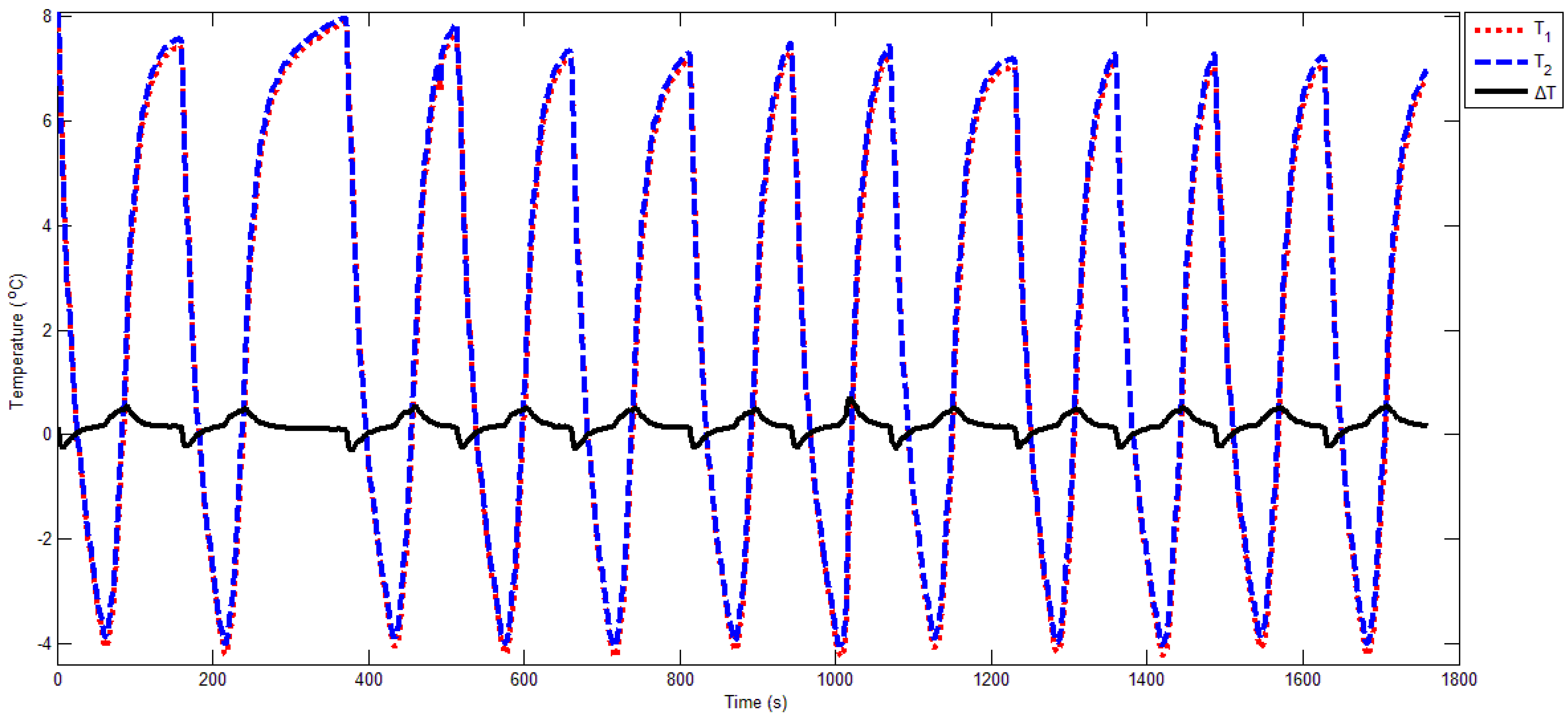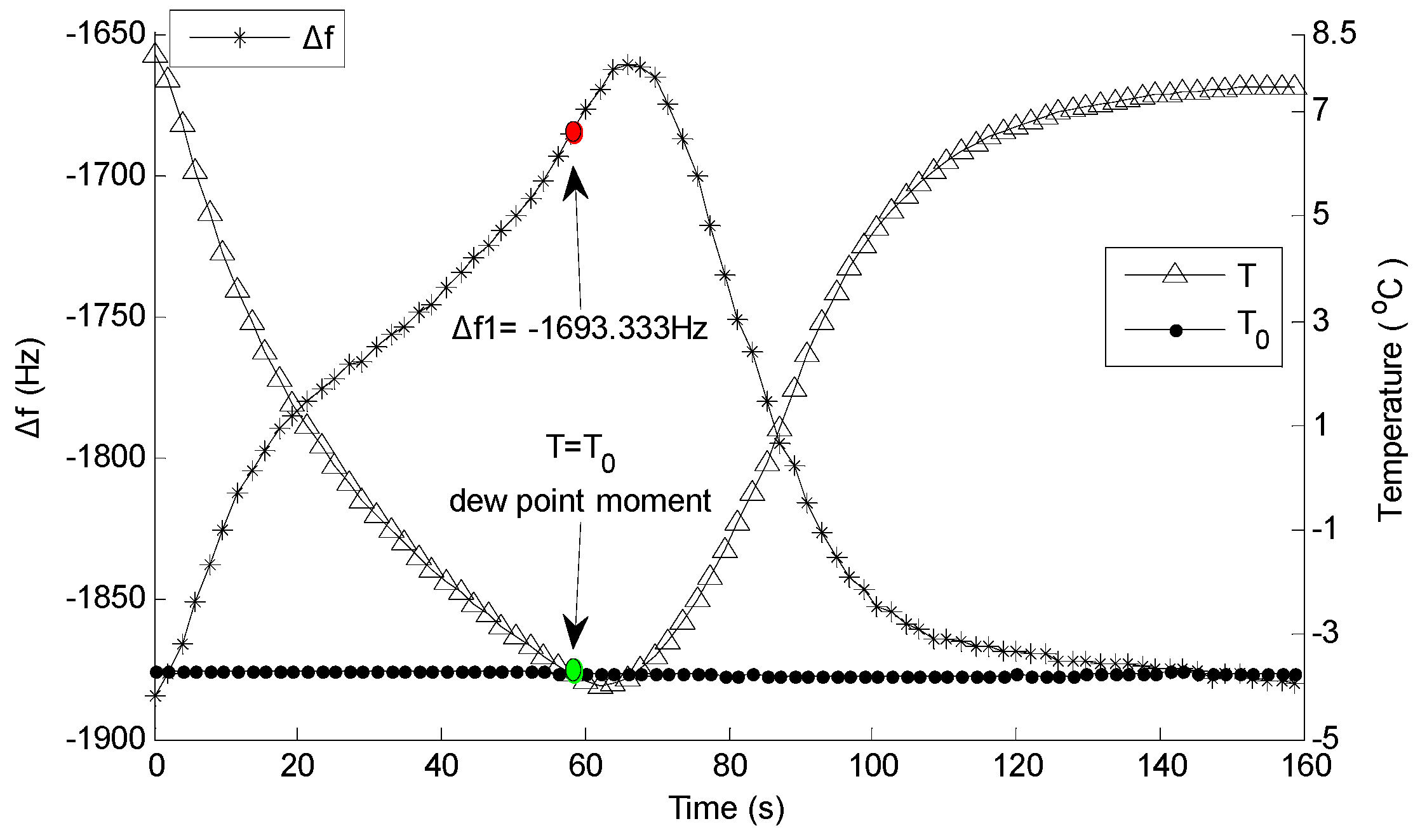Dew Point Calibration System Using a Quartz Crystal Sensor with a Differential Frequency Method
Abstract
:1. Introduction
2. Materials and Methods
2.1. Sensitive Structure
2.2. Experimental Setup
2.3. Spectrum Analysis Method
2.4. Function Realization of Software
3. Experiments and Results
4. Conclusions
Acknowledgment
Author Contributions
Conflicts of Interest
References
- Yuan, Z.; Tai, H.; Ye, Z.; Liu, C.; Xie, G.; Du, X.; Jiang, Y. Novel highly sensitive QCM humidity sensor with low hysteresis based on graphene oxide (GO)/poly(ethyleneimine) layered film. Sens. Actuators B Chem. 2016, 234, 145–154. [Google Scholar] [CrossRef]
- Blank, T.A.; Eksperiandova, L.P.; Belikov, K.N. Recent trends of ceramic humidity sensors development: A review. Sens. Actuators B Chem. 2016, 228, 416–442. [Google Scholar] [CrossRef]
- Squillaci, M.A.; Ferlauto, L.; Zagranyarski, Y.; Milita, S.; Müll, K.; Samorì, P. Self-assembly of an amphiphilic pi-conjugated dyad into fibers: Ultrafast and ultrasensitive humidity sensor. Adv. Mater. 2015, 27, 3220–3220. [Google Scholar] [CrossRef]
- Liu, Y.; Huang, H.; Wang, L.; Liu, B.; Cai, D.; Wang, D.; Wang, C.; Li, H.; Wang, Y.; Xie, W. Enhanced sensitivity of a GHz surface acoustic wave humidity sensor based on Ni(SO4)0.3(OH)1.4 nanobelts and NiO nanoparticles. J. Mater. Chem. C 2015, 3, 866–873. [Google Scholar]
- Sikarwar, S.; Yadav, B.C. Opto-electronic humidity sensor: A review. Sens. Actuators A Phys. 2015, 233, 54–70. [Google Scholar] [CrossRef]
- Jame, C.; Blanco, S.T.; Artal, M.; Rauzy, E.; Otín, S.; Velasco, I. Dew points of binary carbon dioxide + water and ternary carbon dioxide + water + methanol mixtures: Measurement and modelling. Fluid Phase Equilib. 2004, 216, 85–93. [Google Scholar]
- Vetelino, K.A.; Story, P.R.; Mileham, R.D.; Galipeau, D.W. Improved dew point measurements based on a SAW sensor. Sens. Actuators B Chem. 1996, 35, 91–98. [Google Scholar] [CrossRef]
- Hadjiloucas, S.; Irvine, J.; Keating, D.A. Feedback dew-point sensor utilizing optimally cut plastic optical fibres. Meas. Sci. Technol. 1999, 11, 1–10. [Google Scholar] [CrossRef]
- Underwood, R.J.; Cuccaro, R.; Bell, S.; Gavioso, R.M.; Ripa, D.M.; Stevens, M.; de Podesta, M. A microwave resonance dew-point hygrometer. Meas. Sci. Technol. 2012, 23, 85905–85913. [Google Scholar] [CrossRef]
- Baglio, S.; Castorina, S.; Sacco, V.; Savalli, N.; Tringali, C. Dew-point relative humidity CMOS microsensors. In Proceedings of the IEEE Sensors, Vienna, Austria, 24–27 October 2004; pp. 103–106.
- Vashist, S.K.; Vashist, P. Recent Advances in Quartz Crystal Microbalance-Based Sensors. J. Sens. 2011, 2011, 539–556. [Google Scholar] [CrossRef]
- Funari, R.; Della, V.B.; Carrieri, R.; Morra, L.; Lahoz, E.; Gesuele, F.; Altucci, C.; Velotta, R. Detection of parathion and patulin by quartz-crystal microbalance functionalized by the photonics immobilization technique. Biosens. Bioelectron. 2015, 67, 224–229. [Google Scholar] [CrossRef] [PubMed] [Green Version]
- Rasheed, P.A.; Sandhyarani, N. Quartz crystal microbalance genosensor for sequence specific detection of attomolar DNA targets. Anal. Chim. Acta 2015, 905, 134–139. [Google Scholar] [CrossRef] [PubMed]
- Wang, X.H.; Ding, Y.F.; Zhang, J.; Zhu, Z.-Q.; You, S.-Z.; Chen, S.-Q.; Zhu, J. Humidity sensitive properties of ZnO nanotetrapods investigated by a quartz crystal microbalance. Sens. Actuators B Chem. 2006, 115, 421–427. [Google Scholar] [CrossRef]
- Kwon, S.Y.; Kim, J.C.; Choi, B.I. Accurate dew-point measurement over a wide temperature range using a quartz crystal microbalance dew-point sensor. Meas. Sci. Technol. 2008, 19, 283–283. [Google Scholar] [CrossRef]
- Erola, A.; Okurb, S.; Yağmurcukardeş, N.; Arıkan, M.Ç. Humidity-sensing properties of a ZnO nanowire film as measured with a QCM. Sens. Actuators B Chem. 2011, 152, 115–120. [Google Scholar] [CrossRef]
- Nie, J.; Meng, X. Dew point and relative humidity measurement using a quartz resonant sensor. Microsyst. Technol. 2013, 20, 1311–1315. [Google Scholar] [CrossRef]
- Rocklein, M.N.; Georg, S.M. Temperature-induced apparent mass changes observed during quartz crystal microbalance measurements of atomic layer deposition. Anal. Chem. 2003, 75, 4975–4982. [Google Scholar] [CrossRef]
- Jiang, H.; Bo, Y. New design of double-core QCM system. In Proceedings of the International Conference on Microwave and Millimeter Wave Technology, Chengdu, China, 8–11 May 2010.
- Falconi, C.; Zampetti, E.; Pantalei, S.; Falconi, C.; Zampetti, E.; Pantalei, S.; Martinelli, E.; DiNatale, C.; D’Amico, A.; Stornelli, V.; et al. Temperature and flow velocity control for quartz crystal microbalances. In Proceedings of the 2006 IEEE International Symposium on Circuits and Systems, Island of Kos, Greece, 21–24 May 2006; pp. 4399–4402.
- Esmeryan, K.D.; Avramov, I.D.; Radeva, E.I. Temperature behavior of solid polymer film coated quartz crystal microbalance for sensor applications. Sens. Actuators B Chem. 2015, 216, 240–246. [Google Scholar] [CrossRef]
- Sartore, L.; Barbaglio, M.; Borgese, L.; Bontempi, E. Polymer-grafted QCM chemical sensor and application to heavy metal ions real time detection. Sens. Actuators B Chem. 2011, 155, 538–544. [Google Scholar] [CrossRef] [PubMed]
- Nie, J.; Meng, X.F.; Zheng, R.; Wang, S. Fast quartz resonant sensors for high humidity range 60–95% RH. Sens. Actuators B 2013, 185, 211–217. [Google Scholar] [CrossRef]
- Pascal-Delannoy, F.; Sorli, B.; Boyer, A. Quartz Crystal Microbalance (QCM) used as humidity sensor. Sens. Actuators A Phys. 2000, 84, 285–291. [Google Scholar] [CrossRef]
- Mills, C.A.; Chai, K.T.C.; Milgrew, M.J.; Mills, C.A.; Chai, T.K.C.; Milgrew, M.J.; Cooper, J.M.; Cumming, D.R.S. A Multiplexed Impedance Analyzer for Characterizing Polymer-Coated QCM Sensor Arrays. IEEE Sens. J. 2006, 6, 996–1002. [Google Scholar] [CrossRef] [Green Version]
- Iqba, N.; Mustafa, G.; Rehman, A.; Biedermann, A.; Najafi, B.; Lieberzeit, P.A.; Dickert, F.L. QCM-Arrays for Sensing Terpenes in Fresh and Dried Herbs via Bio-Mimetic MIP Layers. Sensors 2010, 10, 6361–6376. [Google Scholar] [CrossRef] [PubMed]
- Abe, T.; Li, X. Dual-Channel Quartz-Crystal Microbalance for Sensing Under UV Radiation. IEEE Sens. J. 2007, 7, 321–322. [Google Scholar] [CrossRef]
- Dunham, G.C.; Benson, N.H.; Petelenz, D.; Janata, J. Dual Quartz Crystal Microbalance. Anal. Chem. 1995, 67, 267–272. [Google Scholar] [CrossRef]
- Zhang, C.; Feng, G.; Gao, Z. Development of a new kind of dual modulated QCM biosensor. Biosens. Bioelectron. 1997, 12, 1219–1225. [Google Scholar] [CrossRef]
- Resa, P.; Castro, P.; Rodríguez-López, J.; Elvira, L. Broadband spike excitation method for in-liquid QCM sensors. Sens. Actuators B Chem. 2012, 166–167, 275–280. [Google Scholar] [CrossRef] [Green Version]
- Jbari, A.; Bellarbi, L.; Zine, N.; Errachid, A.; Bellarbi, L.; Samitier, J.; Jbari, A. Multiplexed Frequency Spectrum Analyzer Instrumentation for the Characterization of Multiple QCM-Based Biosensors. In Proceedings of the International Conference on Sensor Technologies and Applications, Valencia, Spain, 14–20 October 2007; pp. 436–440.








| Δf1 (Hz) | Δf2 (Hz) | df (Hz) |
|---|---|---|
| −1693.333 | −1880.200 | 186.867 |
| −1695.349 | −1880.200 | 184.851 |
| −1694.338 | −1891.306 | 196.968 |
| −1696.354 | −1885.244 | 188.890 |
| −1697.363 | −1890.293 | 192.930 |
| −1701.399 | −1892.310 | 190.911 |
| −1695.337 | −1892.310 | 196.973 |
| −1695.333 | −1893.311 | 197.978 |
| −1698.361 | −1893.311 | 194.950 |
| −1698.358 | −1895.327 | 196.969 |
| −1700.373 | −1898.355 | 197.982 |
© 2016 by the authors; licensee MDPI, Basel, Switzerland. This article is an open access article distributed under the terms and conditions of the Creative Commons Attribution (CC-BY) license (http://creativecommons.org/licenses/by/4.0/).
Share and Cite
Lin, N.; Meng, X.; Nie, J. Dew Point Calibration System Using a Quartz Crystal Sensor with a Differential Frequency Method. Sensors 2016, 16, 1944. https://doi.org/10.3390/s16111944
Lin N, Meng X, Nie J. Dew Point Calibration System Using a Quartz Crystal Sensor with a Differential Frequency Method. Sensors. 2016; 16(11):1944. https://doi.org/10.3390/s16111944
Chicago/Turabian StyleLin, Ningning, Xiaofeng Meng, and Jing Nie. 2016. "Dew Point Calibration System Using a Quartz Crystal Sensor with a Differential Frequency Method" Sensors 16, no. 11: 1944. https://doi.org/10.3390/s16111944






